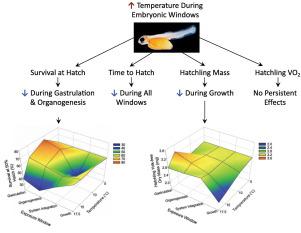Comparative Biochemistry and Physiology A: Molecular & Integrative Physiology ( IF 2.1 ) Pub Date : 2020-11-02 , DOI: 10.1016/j.cbpa.2020.110834 Christopher L Melendez 1 , Casey A Mueller 2

|
Temperature is a crucial environmental factor that influences physiological functions in fishes, and increased temperature during development can shape an organism's phenotype. An active line of inquiry in comparative developmental physiology is whether short-term exposure to thermal changes have lasting phenotypic effects. This is the first study to apply a developmental 3-dimensional critical window experimental design for a vertebrate, using time, temperature, and phenotypic response (i.e., variables measured). Rainbow trout (Oncorhynchus mykiss) are an anadromous species for which resident populations occupy freshwater environments that are likely impacted by variable and rising temperatures, particularly during embryonic development. To assess thermal effects on fish development, we examined trout hatchling phenotypes following rearing in constant temperatures (5, 10, 15 and 17.5 °C) and following exposure to increased temperature above 5 °C during specific developmental windows. Time to 50% hatch, hatchling mass and body length showed general trends of decreasing with increasing constant temperature, and survival was highest in constant 10 °C incubation. Thermally shifting embryos into 17.5 °C during gastrulation and organogenesis reduced survival at hatch compared to 10 °C, and exposure to 15 and 17.5 °C only late in development produced lighter and shorter hatchlings. Oxygen consumption rate (V̇o2) at organogenesis differed between embryos incubated constantly in increased temperature or exposed only during organogenesis, but generally we found limited temperature effects on V̇o2 that may be due to high data variability. Collectively, these results suggest that survival of rainbow trout hatchlings is most sensitive to 17.5 °C exposure during gastrulation and organogenesis, while warm water exposure later in development has greater impacts on morphology. Thus, trait-specific critical windows of thermal sensitivity exist for rainbow trout embryos that alter the hatching phenotype.
中文翻译:

发育窗口期间胚胎温度升高对虹鳟鱼(Oncorhynchus mykiss)的存活,形态和耗氧量的影响
温度是影响鱼类生理功能的关键环境因素,在发育过程中温度升高会影响生物体的表型。在比较发育生理学中,一个积极的问题是短期暴露于热变化是否具有持久的表型效应。这是第一项利用时间,温度和表型响应(即测得的变量)对脊椎动物应用发育性3维临界窗口实验设计的研究。虹鳟鱼(Oncorhynchus mykiss)是一种有害物种,常住人口居住在淡水环境中,这可能会受到温度变化和上升的影响,特别是在胚胎发育期间。为了评估对鱼类发育的热效应,我们研究了在恒定温度(5、10、15和17.5°C)下饲养后以及在特定发育窗口中暴露于高于5°C的升高温度后的鳟鱼孵化表型。孵化率,孵化质量和体长达到50%的时间显示出随着恒温温度升高而总体下降的趋势,并且在10°C的恒温培养中存活率最高。与10°C相比,在促胃和器官发生过程中将胚胎热转移到17.5°C会降低孵化率,并且仅在发育后期才暴露于15和17.5°C会产生更轻,更短的孵化率。Ò 2)在器官发生的胚胎之间差异在升高的温度下不断孵育或仅器官期间暴露,但通常我们发现开V有限温度效应Ò 2由于高变异性数据可能。总的来说,这些结果表明虹鳟鱼幼体的存活对在胃排毒和器官发生期间暴露于17.5°C最为敏感,而在发育后期暴露于热水对形态的影响更大。因此,对于虹鳟鱼胚胎存在改变孵化表型的热敏性状特定的临界窗口。









































 京公网安备 11010802027423号
京公网安备 11010802027423号